Newsletter of the 14 Squadron Association
Mike Napier
Hon Sec’s Report
Reunion ‘05
The Association’s Annual Reunion was held on 8th October, once again at the Garden House Hotel in Stamford. Despite a rather disappointing turnout of only 23, I understand that the evening was a great success and the hotel once again provided an excellent venue and menu. The following attended: Arthur Galilee, Brian Dutton, Steve & Liane Cockram, Tim & Ursula Anderson, Binky & Jane Wells, Paddy Shiels, Ed & Eileen Jones, Mac Furze, Doug & Pat Wilson, Stu & Polly Morton, Deryck Stapleton, John & Mary Galyer, Jim & Shirley Sewell, Bill & Olive Yates.
The relatively low level of support for the Reunion once again begs the question as to whether the location and format meet the wishes of the membership. You may remember that we moved away from the “traditional” venue at the Victory Services club in London in the hope that we could encourage more people to support the event, which seemed to work well in 2004, but has tailed off this year. Options for next year include moving back south (perhaps back to London and the even the VSC), staying in Stamford, or going to RAF Cottesmore. It would be very helpful if members could give me some indication of their preferences. I am happy to arrange an Annual Reunion for as long as people (however few in number!) wish to attend, but clearly I would wish to provide a service that attracts as many as possible. Answers on a post card, please!
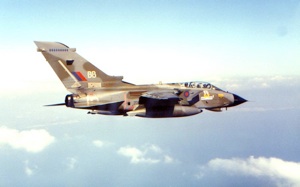
Mike Napier & Doug Steer descending into Akrotiri, Feb 1986
People
I am delighted to say that I have been quite busy keeping in touch with a number of Old Crusaders scattered round the globe. This is where e-mail is a particularly useful tool. Apart from just keeping in touch, I’ve been able to do quite a bit of research into various of the surprising number of enquiries that come my way from relatives of personnel who have served with the Squadron in the past.
Downunder
I’ve been in regular e-mail contact with Colin Campbell out in Australia, who has kindly sent me a number of photos and answered many queries about his experiences on the Squadron. Also in Australia, I’ve been in frequent contact with John Robertson, who with great patience has helped me with many questions, has provided a number of photographs for inclusion in the centenary Project (more of which later) and has also been persuaded to write a few lines on his part in the finding and sinking of the Italian liner Rex in 1944. I will include the latter in a future issue. It was also through e-mail that I was able to “reunite” John with his Wop/AG Dick Froom from Chivenor days – they hadn’t had any contact since 1945! Dick had seen a copy of “The Old Crusader” during a visit to Lyneham and contacted me as a result of seeing John’s name among the list of members. Returning to the Australian theme, I’m delighted to have established e-mail contact with Bill Cavanagh who has also been another source of information and photographs and who has also greatly helped with the research of the nephew of Herb Ford who was killed while flying as John Willis’ navigator on a mining sortie to Tunis on xx Dec 1942. I’ve also heard through the more traditional postal letter from Wal Clarke-Hall and Lionel Copp who are on good form in Australia.
Wartime Chaps
Closer to home I was very glad to speak by phone fairly recently to Dick Marshall and also Jim Hanson, who are both in good spirits; Joe Lowder is another frequent “phone correspondent” who manages to keep smiling despite inconveniences with his and Marjorie’s health. Joe has also very kindly provided answers to numerous questions and a number of photographs of squadron life on Corsica in 1944. Another source of wartime photographs of Squadron personnel has been Dick Slatcher who sent me a fantastic collection which included a number of Marauder crews. Alas, some of the people on the photos are unidentified; I’ve put some on the website in the hope that someone, somewhere might recognise some faces. Some of our members have been “in the wars” lately: Dick Maydwell had his car written off during the summer but very fortunately managed to escape unscathed, and his erstwhile air gunner Gil Graham shook himself up somewhat when he unintentionally dived off a ladder recently and then suffered a stroke. Both assure me that they are recovering from their experiences! You may remember a photo of a crashed 14 Squadron Blenheim which appeared in the “readers photos” part of the Daily Mail a few years ago and which Joe included in a newsletter – well after a brief bit of detective work I’m very pleased to say that I managed to track down RG Dawson who served with the squadron throughout the Desert war – mainly it seems collecting bits of broken aircraft from the length and breadth of north Africa - and who has provided me with some fascinating stories and photos which I will include in future editions of this newsletter.
Mataro Marauder
The wreckage of this aircraft is of great interest to us because it is, as far as I know, the only 14 Squadron Marauder still in existence (albeit 100 feet underwater and somewhat shattered!). Peter Dawson continues his research into the loss of this aircraft off the coast of Spain in 1944. A major breakthrough has been contacting an aeronautical historian in Spain who has, we think, been able to identify the ship which the aircraft was circling when it crashed. Additionally I have written up Peter’s research as an article for Flypast magazine, which should be published in [I believe] the February edition; a further article about the incident is being prepared for the Australian Forces newspaper by one of their reporters. We’re slowly getting all the pieces of the jigsaw together and it would be wonderful if the publicity and research meant that we could finally determine exactly what happened to the aircraft and its crew on that fateful day.
Mosquito Men
Mike Levy, whose adventures as a young Mosquito pilot have been serialised in the previous three issues of this newsletter, has helped greatly providing information for an enquirer whose father served on the Squadron as a Mosquito navigator. Alas, Mike has recently suffered from both a minor heart attack and a stroke. But his sense of humour remains intact and I’m sure we all wish him well in his recuperation.
Collision with a Taxi at 2000 Feet!
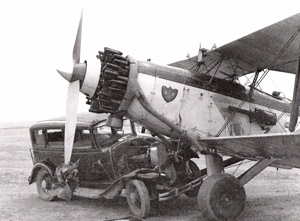
Yes, you’ve guessed it, Amman in Jordan is 2000 feet above sea level.
Thanks to L Tully for this fantastic photo of a 14 Squadron Fairey Gordon after an altercation with a local taxi circa 1937.
Vampire/Venom Gang
Contemporaries from Venom days Mike de Torre andDave (Sandy) Sanderson have both been in touch with me and hopefully by now each other, too.
Hunter People
I’m delighted to report that Tom Sharples and George Ecclestone have both been in touch, having discovered the Association’s existence during a visit to RAF Marham. Tom’s story of one of George’s misdemeanours appears later in this edition! Many thanks, too, to Frank Davies for a series of photos of Hunters and personnel from days at Aalhorn and Sylt.
Canberra Crew
It’s good to report that Mac Furze is back in action again after having suffered a heart attack early last year and my thanks to Bill Yates for keeping me updated with Mac’s progress. I hope that I have been able to reunite Ernie Coppard and Phil Wilkinson who were crewed together in the Canberra days. Many thanks to Stewart Airey and Jim Sewell for their further stories about WT346 which appear in the following pages.
Tornado Folk
Congratulations to Windy Gale who is now a Wing Commander running one of the RAF’s Typhoon units; also to Steve Cockram who got an OBE in the New Year’s Honours List. Steve is now pushing paper round the MoD, having completed his tour as OC II Sqn. Also pushing paper (but at Strike Command) is our erstwhile Hon Treasurer Dougie Potter, while our Vice president Tim Anderson is running the Air Warfare Centre up at Waddington. Back flying, Mal Craghill is up at Lossiemouth running QWI courses. In civvy street I have seen Ian Walton, now flying the A320 for British Airways, as does Ian Cousins; just retiring from the BA Airbus fleet is Iain Hunter, who I believe is looking at moving across to easyJet or BMed. Also nearing retirement is Doug Steer, who moves back to UK when he leaves the RAF sometime in ’06. And just to show what a small world it is, my brother who is in the army at the NATO HQ at Brunssum (formerly AFCENT from Cold War days!) tells me his new next door neighbour is Bob Wright. Mark Sutton (Sooty) has just moved out to Hong Kong with Cathay Pacific and seems to be enjoying it. “GT” Taylor has also retired from his post as Prop Rects Controller on the Squadron to embark on a new career as a long distance lorry driver. Also new to the Association are Liz Bowyer and-Jim Frampton - welcome aboard! Finally, I understand that Tim Rust is now flying for DHL, but await a report as to how it is going!
Welcome
Welcome to the following new members who have signed up since the last issue: Dick Froom (1944-45), Ron Dawson (1941-45), George Ecclestone (1962-63), Tom Sharples (1963), Liz Bowyer (2002-04), Jim Frampton (2005- ) and GT Taylor (2002-06)
In Memoriam
I am very sorry to report that the following have been posted to the great squadron in the sky: Sam Allen, an armourer on Hunters in the early ‘60s, Maurice Best groundcrew from 1940-44, and his contemporary, Ron Haley, who served as Squadron cook from Palestine to Corsica, Dickie Adams, who was a Vampire and Venom pilot between 1952-54, and also served (though I didn’t realise it) as a Canberra pilot in the mid ‘60s too, Ron Gilbey, a Wop/AG on Wellingtons from 1944-45 and finally T E Bullas, who was also a Wop/AG on Marauders from 1942-43.
That’s All, Folks!
Mike Napier
Canberra WT346 - The Story continues!
Stewart Airey writes...
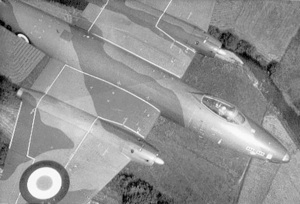
Photo - Doug Wilson
Jim Sewell's discovery of WT346 in bits in New Zealand brought back an incident that is reminiscent of the bucket of bricks story. '346 had the straightest airframe of 14 Sqn's fleet of Canberra B(I)8s, thus having the least change of yaw with speed. This may not seem important to many, but as briefly recounted in the squadron history that accompanied the 90th anniversary, the B(I)8 had a feature shared only with the dozen or so B(I)6s of 213 Sqn.
Not only was the B8 a boring old strike aircraft with the ability to attack targets in eastern Poland from the Dutch border and get at least part of the way back on a LO-LO profile albeit somewhat slowly, at certain times of the year it was transformed into a ground-attack fighter, hence the I (for Interdictor) between the B and the 8. Twice a year a gunpack consisting of four 20mm Hispano cannon was winched into the bomb bay of half a dozen or so of the squadron's aircraft and we became fighter pilots. What the aircraft lacked in performance we made up for in enthusiasm. The Hispano had certain advantages, a reasonable muzzle velocity of 2800 fps at about 550 rounds per minute as I recall, but the much lighter shell carried far less punch than the Aden and the stoppage rate was not impressive.
Thus trueness of the airframe was significant if changes in rudder trim changes were not to be needed during an attack as the aircraft accelerated. Although Her Majesty had gone to considerable expense to provide a gun pack the gunsight was somewhat basic, bolted to the airframe and variable only in pitch. For those accustomed to more modem aiming systems, a crosswind pass required the "pipper" to be placed above and into wind of the target and then the aircraft progressively banked into wind to counter drift as the pipper was dragged down diagonally towards the target while the azimuth bars reflected the increasing bank. This was an interesting exercise in a twin engine aircraft with spectacle controls, relatively heavy ailerons and a twisted airframe. Men were men in those days, those longitudinally disadvantaged or with short legs were sent to the Lightning, Hunter or the dreaded V-force or perhaps to the Navy.
Once a year the fortunate few were dispatched for about a month to one of the fleshpots in the Mediterranean for conventional weapons training. In 1969 the chosen spot was RAF El Adem, about 30 miles south of Tobruk in the Libyan desert. For a break from the hectic night-life of Tobruk, selected crews were permitted to take an aircraft to Akrotiri for the weekend and relax in Cyprus.
Thus it was that Kevin George Toal, whose untimely and tragic death was reported in the previous edition, and I found ourselves about to return to El Adem one Sunday evening in WT 346. We were met at the aircraft by the crew chief who announced that during the B/Fa chafed wire had been found in the undercarriage bay and needed to be changed. They would advise us when the aircraft was ready.
Some time later, we were told that the aircraft was ready but since the wire was in the gear indicator circuit, a retraction test was required, the aircraft had to be put on jacks and we would be advised etc. so we retired to the mess.
In order to prevent inopportune operation of the gear the Canberra had been fitted with a Gear Override Switch. At that time there were at Akrotiri four squadrons of Canberras, B15s and l6s, higher numbers but older and different airframes, with a curious anomaly, the Gear Override and Flap switches had been interchanged. Some time later, we were told that there had been a problem. While carrying out the retraction test: instead of the Gear, the Flaps had been inadvertently lowered, which they could not at first understand.
While this would not ordinarily cause difficulty, Murphy had been working overtime that day and the Flying Control Locks had not been removed. Unfortunately, the aileron locks were a suitably shaped piece of metal inserted between ailerons and flaps to lock the two together. Thus as they selected the "Gear Override switch", there was I imagine an embarrassing grinding noise as the ailerons collectively moved in a manner for which they were not designed and WT346 became no longer the straightest aircraft in the fleet.
The Cyprus Canberras were not compatible with the B(I)8, thus spares were requested from UK. Kevin and I enjoyed a traumatic lifestyle: in the bar until it closed then up at midday for a late breakfast and to check for signals. Finally, on the Wednesday, the Boss could stand it no more and a signal arrived that we were to return to El Adem by the first available means. In those days, Transport Command ran an almost daily service round the Med and Thursday found us on a Britannia back to the Sahara. To this day I do not think we were believed!
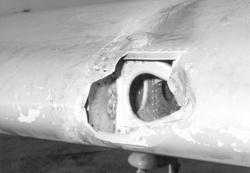
A big ‘ole in the port wing of WT346! - Jim Sewell
Meanwhile, Jim Sewell writes...
Continuing the story of finding WT346 in the RNZAF Museum at Christchurch. I also told you that I had flown the beast whilst on 14 Sqn. The saga continues. I was browsing through my photos prior to going off to the 14 Sqn reunion. One I found is attached.
It is a photo of the port leading edge, outboard of the engine, showing the damage caused by a bird strike when I was flying WT346 on 7 Jan 1966. I was briefed to carry out a NAVAIR 9, a low level round eastern West Germany I seem to remember. I had as an air experience passenger an SACW Coombes and my navigator was Flt Lt Ian Brock.
When we got back to Wildenrath we did some circuits and a GCA. After landing and taxiing back to the Sqn dispersal, engines were stopped and I climbed out of the aircraft. Remember the exit is on the starboard side of a Canberra. At this point one of the ground crew came up to me with a huge smile and asked me what I had been up to. Nothing I said and he then led me round to the port side and showed me the hole in the leading edge.
Believe it or not none us, me, the nav or the passenger, knew we had hit anything. Neither could I see the hole from the cockpit because of the port engine nacelle. As we all know the wing was repaired and WT346 stayed flying long enough to get to New Zealand.
Was I believed about my lack of knowledge of the 'bird strike'? Not really I suspect!
Left, a big ‘ole in the port wing of WT346! Photo - Jim Sewell
You ‘Ave Keel-ed Two ‘Orses!
If you wondered why there is a photo on the association website which features someone pointing to two dayglo horses on the side of a Tornado, read on...
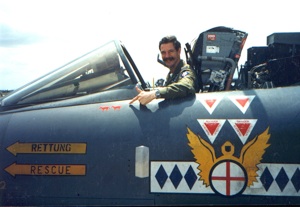
“Frasca, Paris, three aircraft join for level, glide and strafe,” my left hand leaves the transmit switch and wipes the drips of sweat from my eyes. Although it is still early in the day, the sun beats down from a bright azure sky as we leave the mountains at “Point Golf” and head west towards the coastline.
“Rrogerr, Paris forra bom-bing left-a range-a left-a pattern, strafe left-a range right-a pattern!”
“Paris bombing left-left, strafe left-right,” responds Russ “The Beagle”, my erstwhile navigator. We are leading the morning fourship, and The Beagle realises that I am probably too maxed out to take in all the details. I say fourship, but of course being a Tornado formation only three of us have made it airborne. This is week two of my second ever Armament Practice Camp at Deci. Two years into my first tour, and I am keen to show that I really deserve to be a pairs leader. Those first two years haven’t been that kind to me, either, so there is quite a lot of pressure to get it right that morning!
We had arrived early for met brief, eyes still slightly bleary from another night of Sambucca and Cappuccino in the Quadrinational Club. Scanning the skies and the mountains to the Northwest as we reached the ops block, the weather looked pretty good. One less thing to worry about. But Reg, the Squadron QWI (Qualified Weapons Instructor) provided the morning’s fast-ball:
"We've just got clearance to use the laser rangefinder with strafe, so I want you lot to do some laser strafe on your sortie!"
The Beagle and I had a quick conference. Nothing phased the Beagle, a man whose will of iron had been forged in a harsh regime of sitting in the crewroom and smoking sixty cigarettes a day, and he confidently predicted that there could be “no snags”. I could only agree, since The Beagle was a very experienced operator, who had been specifically crewed with me to keep me on the straight and narrow. And so we had quickly planned and briefed the sortie
But now we are approaching the coast-out point and the Beagle and I run through our game plan. We mustn’t score too highly on the Squadron Pigs Board this time, so we rehearse the order of events and who is going to do what during each pass. Most importantly, we remind ourselves who is going to check which switches. And, of course, we go through all the laser switches very thoroughly, because we DON'T want to make a mistake with that.
The bombing part of the sortie goes well. Some reasonable scores there, and now onto the strafing. I come right after my last bombing pass into the strafe pattern.
Downwind at two-and-a-half thousand feet. The Beagle and I run quickly through the checks, there's Number 2 off target now, just need to keep an eye out for the other one. As Number 3 comes off his attack, I roll in for the safety height pass.
"Paris One - In, safety height pass"
"Roger, yorra clear"
We drop down to 350 feet to check that the strafe panel looks OK and that the bay beyond the headland is clear of shipping. "No sheeps in the bay" I call back in time-honoured fashion, as the strafe panels flash past beneath us. A steep climbing turn to the right, and we’re downwind again, ready to start shooting.
Now, in the Tornado, the cadence for a strafe pass should be: turn finals, halfway round start the descent, roll out pointing at the target, check dive angle, "Paris One - In Hot, Lima", weapons safety switches live, "laser's firing" from Russ, check speed, throttle back, gun trigger live, "Clear 'Ot", track the target, 1200 metres, shoot -brrrrp- recover, 4-g, to fifteen degrees nose up, straight ahead to 1500 feet, "Paris One, no 'its", turn downwind. Now, all that takes about as long to actually do it as it does to read it, so you're pretty busy.
And that's how it usually went. Except that today, instead of "No 'its" or even (dream on) "Ten 'its" as the Range Safety Officer scored my first pass, there was silence.
"Paris 2 - In Hot, Lima"
Silence.
“Paris 2 off dry”
"Paris 3 - In Hot, Lima"
Silence.
“Paris 3 off dry”
My turn again "Paris One - In Hot, Lima"
This time it's met by an urgent cry of horror:
"Paris Lead, you 'ave keel-ed two 'orses!!" At which The Beagle, helpfully, bursts into hysterical laughter. He is reduced to a gibbering wreck for the rest of the sortie, and offers no more help other than the occasional loud guffaw from the back seat. The other two can't keep their mirth to themselves, either, and all their subsequent radio calls are punctuated by puerile sniggering. I am mortified. Luckily we soon run out of bullets and range time.
Now word travels fast, so I am rather worried to see the Boss waiting for the formation as we taxy in. But no! He’s come for a glass of bubbly to celebrate the first use of the laser with the Italian Base Commander. Phew, I think, I’ve got away with it! But, as I turn to walk back to the line hut I pass my trusty steed from that fateful sortie, I glance up. There - already - just beneath the cockpit are two Day-Glo horse symbols, courtesy of the fast thinking ground crew!
Needless to say, the cine room was packed out for the debrief as various QWIs clicked through my film frame by frame to see if they could find any horses, but alas none could be seen! And the reason for the untimely death of two innocent horses? A fault in the software for the laser ranger (which I was too stupid to notice) put the aiming pipper way off from where the bullets were actually going...
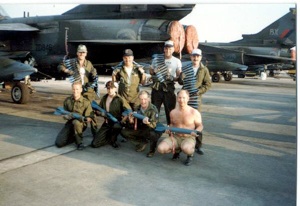
Armourers in their element! The boys at APC Deci 1990 (a couple of years after the horses were shot!) Photo: Dick Lindsay
Trouble with Snowdrops!
Back in 1963, 14 Squadron was a Hunter day fighter squadron on the front line of the Cold War in Germany and our over-riding priority was Battle Flight (now called QRA). On First Line Servicing we did a stint of early shifts, from dawn ‘til noon, or lates, from noon ‘til late afternoon. On our shift, we were a very close-knit crew, and we had a foolproof system for getting the early shift off to a good start. One airman nicknamed Banjo was very good at getting up early, rousing the rest of us and then waking the duty cook as we set off to the hangars. Once there, the first job was to get the Battle Flight pair out and complete the B/F servicing. When that was out of the way it was time for the most important job of the day - to collect the urn of tea from the mess. Whoever finished first would set off in the Battle Flight Landrover, and would normally be back 10-15 minutes later with an urn full of steaming tea. One particular day George Ecclestone had finished all his electrical B/Fs before everyone else, so he was “elected” to go and fetch the tea.
We were getting a bit concerned when we still didn’t have our tea after the usual time had elapsed, but 40 minutes later George reappeared looking a bit shaken. He explained that as he was driving towards the mess, he got mixed up with which side of the road to drive on in Germany and had collided with another Landrover. Unfortunately the other Landrover contained two policemen! It turned out that he didn’t even have a driving licence and had only ever driven on the pan - but he kept quiet about it because he didn’t want to let us down with our early morning cuppa. Needless to say, the policemen were not amused, and I think his good nature that morning cost him several weeks’ jankers!
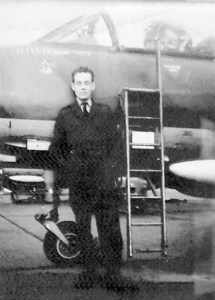
Tom Sharples Tom Sharples poses in front of Flt Lt Carr-Wright’s Hunter at Gutersloh, 1963. Has he had his cuppa yet?



